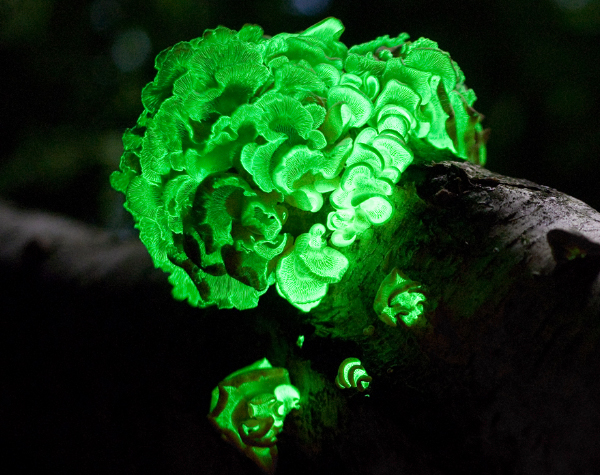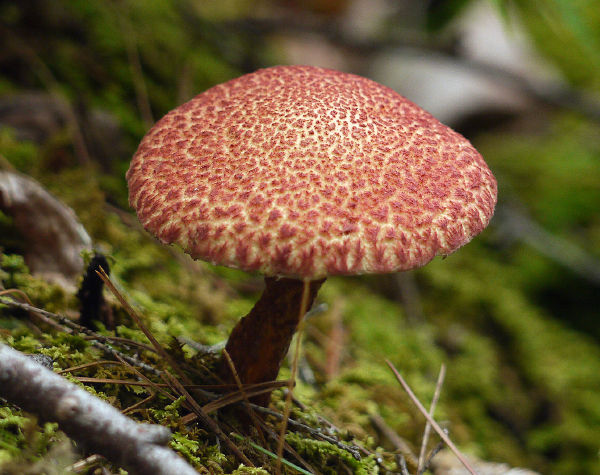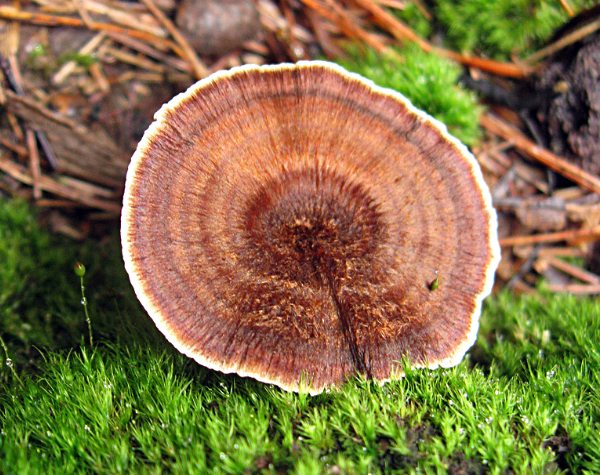Mushrooms, the fruiting bodies of fungi, are especially abundant as the summer winds down and the cold air sets in.
Although some of our local fungi, such as oyster mushrooms, may be more familiar, they’re only a small part of a remarkably diverse world that includes glow-in-the-dark, multicolored, and gargantuan species.
Here are five amazing mushrooms to look for.
Chrome-footed bolete
Harrya chromapes
This two-toned mushroom looks like it’s lit from below. Although many of us think of “chrome” as a silvery coating on metals, painters used to use a pigment called chrome yellow that was made from lead and chromium (it’s no longer in use because it’s toxic). You’ll find this mushroom growing on the forest floor.

Luminescent panellus
Panellus stipticus
Though it isn’t remarkable-looking during the daytime, it glows green in the dark (see second photo, which was exposed for a long period to gather more light). The purpose of this luminescence is unknown. Not all specimens glow, and the amount of glow seems to vary by location. Look for it on logs and sometimes in the wounds of hardwood trees such as birch, oak, and maple.


Ylem, Wikimedia Commons
Painted suillus
Suillus spraguei
The painted suillus looks like a pointillist artist carefully covered it in fine red dots. As with most fungi, the mushroom part is just the tip of the iceberg—a network of fungal threads spread through the soil below, intertwining with the roots of nearby pine trees. Both the painted suillus and the pine benefit from this connection. The fungus receives moisture and nutrients, and the tree uses the fungus to extend its root system.
Berkeley’s polypore
Bondarzewia berkeleyi
This is a true giant (note my boot in the bottom right corner of the photo). It can form clumps that are three feet wide or more, and feeds on living and dead hardwood trees. Its namesake, Miles Joseph Berkeley, was a 19th century British clergyman who was very important to the early study of fungi.
Fairy stool
Coltricia cinnamomea
This velvety, vase-shaped mushroom looks like it would make a comfortable seat for a tiny woodland creature. It’s usually less than two inches wide. Look for the fairy stool in mossy areas beside paths, where it feeds on underground tree roots and wood.
Looking to learn more? Take a fungi walk with us!





Thanks for this blog posting. I have eaten the Chrome-footed Bolete – they are pretty tasty, esp. when gathered young and firm and cooked relatively soon after picking. I have also eaten the Painted Suillus, and would offer the same advice for that one, too, although it is not as yummy as the Chrome-foot. I have also heard that Berkeley’s Polypore is edible, although I have never tried it, and what I have heard from others indicates that it is not particularly yummy.
BTW – pending favorable weather conditions (i.e., several good rainstorms in the interim), I expect to encounter several edible wild mushroom species on the foraging walk I’ll be leading at Felix Neck as part of its ‘Fin and Feather at Fifty’ celebration on Sun. October 11. Click here for more info: http://www.massaudubon.org/get-outdoors/wildlife-sanctuaries/felix-neck/news-events/fern-feather-at-50-fest
Whoops – I should have said Sunday, October 12 (not the 11th).
interesting. Every year I seestrange and unusual mushrooms of all dfferent shapes and colors. This year, I saw a huge giant puffball near my brother’s place as well as weird orange spiky mushrooms on cape Cod